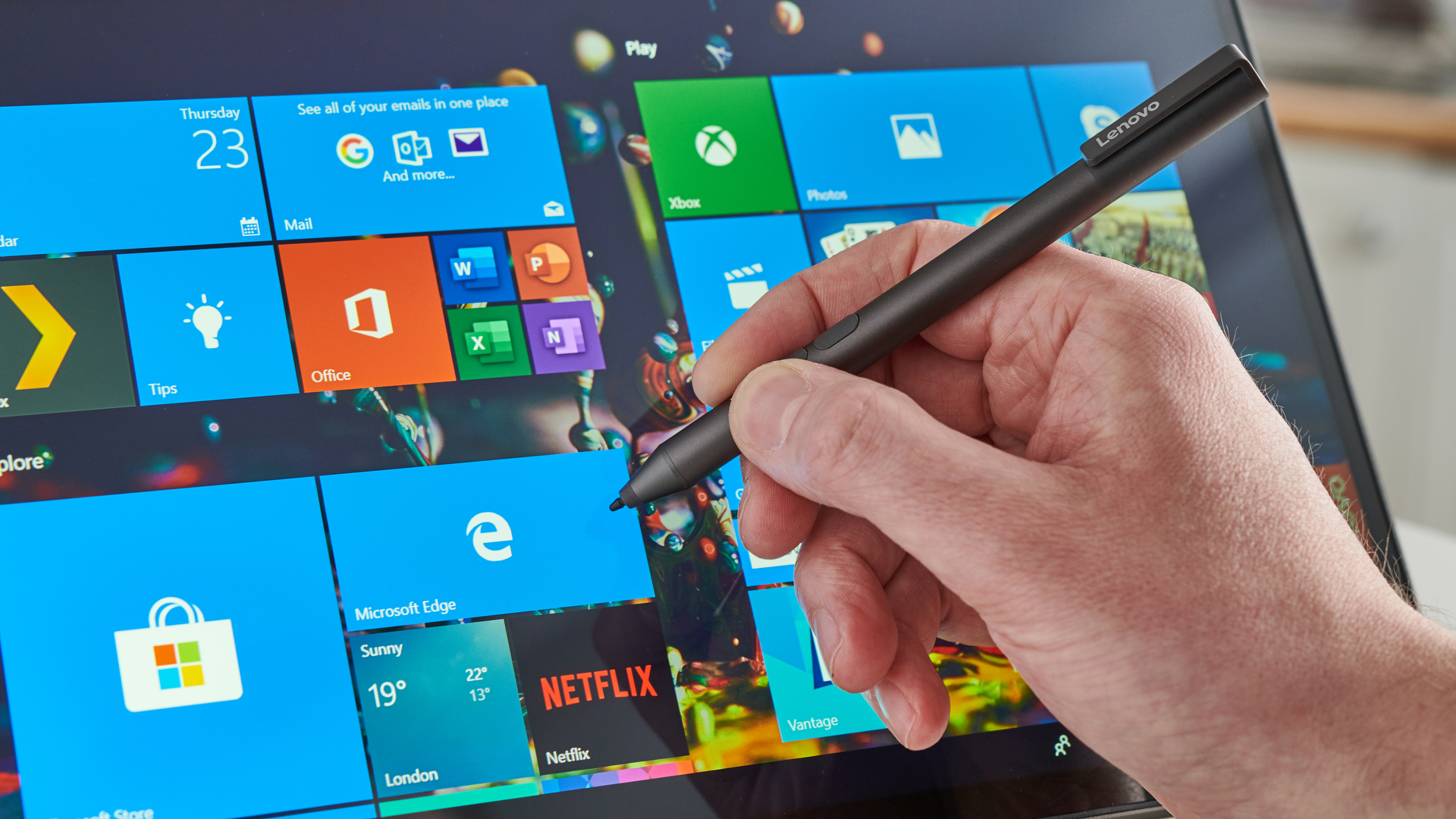Why you can trust TechRadar
Here’s how the Lenovo Yoga C630 performed in our suite of benchmark tests:
GeekBench: 2,291 (single-core); 7,101 (multi-core)
Battery Life (TechRadar movie test): 23 hours and 46 minutes
The biggest issues we’ve had with previous Snapdragon-powered Windows laptops is that their performance has often fallen well short of what we’ve come to expect from laptops in their price range. All too often, the benefits of the mobile platform have been overshadowed by a sluggish and frustrating experience when using Windows 10.
Lenovo claims the new Snapdragon 850 that powers the Yoga C630 offers a 30% performance increase over previous Snapdragon platforms. With an octa-core Kryo 385 processor running at up to 2.96GHz, on paper this should result in a decently performing laptop, and we’re pleased to say that compared to older Snapdragon laptops, like the HP Envy x2, the Lenovo Yoga C630 offers drastically improved experience.
Just look at the benchmarks. The HP Envy x2 scored 770 (single-core) and 3,116 (multi-core) in the GeekBench tests, while the Yoga C630 easily surpasses it with a single-core score of 2,291 and a multi-core score of 7,101. That’s a big uptick in performance, and in our real-world tests we also saw the Yoga C630 perform much better than the Envy x2.

It’s not going to match the performance of a laptop toting the latest Intel Core CPUs, but for day-to-day work, including web browsing and word processing, as well as opening compressed folders, the Yoga C630 managed to keep up, although there was sometimes a slight pause when loading apps. However, it’s really worth noting how much better the Yoga C630 feels in use compared to the Envy x2, which is thanks to both the Snapdragon 850 platform and the boosted RAM (it comes with 8GB, twice that of the Envy).
There are some performance caveats, however, that could impact on how useful you find the Lenovo Yoga C630. For a start, it comes in Windows 10 S mode by default. This limits you to only being able to install programs and apps through the Microsoft Store app. Microsoft claims this mode boosts the security of your device, as you can’t download and run any dodgy files from the internet.
In reality though it's mainly a nuisance, as relatively few app makers have developed a bespoke app for the Microsoft Store, which means you’re either having to rely on the thin selection of offerings, or go without.
If Microsoft manages to achieve what it’s long failed to do, and expand the amount of apps available in the Microsoft Store, then Windows 10 S Mode wouldn’t feel so limiting. Until then, however, you can at least upgrade from S Mode to the full Windows 10 experience – this is done through the Microsoft Store, and it’s quick, easy and free. We can’t imagine many people not doing this, so it’s a bit strange that both Microsoft and Lenovo are persevering with S Mode.
However, even when you leave Windows 10 S mode, you’re still limited as to what programs you can use. This is because most Windows 10 programs are designed for Intel and AMD hardware, and Windows on Snapdragon devices have different architecture, which means developers have to make special version; so, while you can still download the programs, you may not be able to install and run them.
Hopefully the number of programs you can run on the Yoga C630 – and other Snapdragon-powered laptops – will rise in the future, but for now you should be warned that the range of apps is limited, and that might be a deal-breaker for many people.

Battery life
One area where Snapdragon-based laptops always excel is battery life, and the Lenovo Yoga C630 achieves some of the best results we’ve seen. In our battery life benchmark test, which involves playing a looped 1080p video with the screen set to 50% brightness, the Yoga C630 lasted a truly impressive 23 hours and 46 minutes.
That’s easily one of the longest battery lives we’ve seen in a laptop, and quite a bit longer than the Envy x2’s still-impressive 18 hours and four minutes.
In our day-to-day testing, we made it through whole work days without needing to charge the Yoga C630. In fact, we never ran out of battery – it would still have juice when we’d plug it in at the end of a long day, and we were only plugging it in out of habit.
So, if you’re looking for a productivity laptop that can last multiple days on the road while connected to the internet, the Lenovo Yoga C630 is definitely worth considering.
Verdict
Finally, it looks like there’s a Windows-on-Snapdragon laptop that lives up to the promise of combining the best of laptops and mobile devices. While the Lenovo Yoga C630 isn’t perfect, it improves on many of the failings that plagued previous WOS devices.
Performance no longer feels like it’s been compromised. While you can’t play the latest, graphics-intensive games, or run power-hungry tasks, the day-to-day experience of using Windows 10 is drastically improved.
As with other WOS laptops, the inclusion of 4G connectivity is incredibly useful, and its integration within Windows 10 is flawless. Being able to open the laptop, have Windows 10 start instantly, and browse the internet without having to connect to Wi-Fi still feels genuinely innovative – and the Yoga C630 manages it all with aplomb.
As long as you’re able to get a connection, 4G does a fine job of enabling you to browse web pages, download medium to large files, and stream high-definition video – and the fact that the laptop comes with a bundled data SIM is also welcome.
However, it's worth noting that we’ll soon see WOS devices with 5G connectivity. The potential this new network provides is staggering – you'll be able to download 4K videos and other huge files in seconds – and it could make 4G-toting laptops like the Yoga C630 feel ancient.
There are still some niggles with this device but then many of them are outside Lenovo’s control. Windows 10 S mode is still pointless, considering how sparse the Microsoft Store is, and how few benefits the mode actually brings.
The fact that you can so easily upgrade to full Windows 10 is welcome, but it shows how little faith Microsoft has in S mode, and even though it’s easy to switch we’d rather the C630 simply shipped with full Windows 10 as the default.
A more pressing issue is the relative lack of programs that can run Windows on Snapdragon. This limits the apps you’re able to use, and the problem won’t get fixed until either developers create a version of their software that runs on ARM processors (which takes money and resources), or Microsoft improves emulation that allows Windows on Snapdragon to run normal Windows 10 programs without too much of a performance hit – but who knows when that day will come.
So, what about a score? Well, here’s where we have a dilemma when it comes to the price difference in the US and UK. The US price of $549 makes this an easy laptop to recommend – it's a fantastic price, especially as the C630 offers much better performance than the Envy x2 for a lot less cash.
In the UK, however, the £929.99 asking price makes this a much tougher laptop to recommend. That price tag puts it in premium laptop territory, and you’ll be able to get a much more powerful laptop for similar money, albeit without the long battery life and 4G connectivity.
As mentioned, such is the price disparity between the US and UK that we’ve contacted Lenovo to find out why this is. Perhaps the UK will see a price cut in the future, but for now you should subtract a star from this review if you’re buying it in the UK, and that's a shame.
- Check out our pick of the best laptops of 2019

Matt is TechRadar's Managing Editor for Core Tech, looking after computing and mobile technology. Having written for a number of publications such as PC Plus, PC Format, T3 and Linux Format, there's no aspect of technology that Matt isn't passionate about, especially computing and PC gaming. He’s personally reviewed and used most of the laptops in our best laptops guide - and since joining TechRadar in 2014, he's reviewed over 250 laptops and computing accessories personally.
